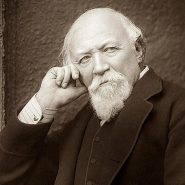I because I could not stop for Death –
He kindly stopped for me –
The Carriage held but just Ourselves –
And Immortality.
We slowly drove – He knew no haste
And I had put away
My labor and my leisure too,
For His Civility –
We passed the School, where Children strove
At Recess – in the Ring –
We passed the Fields of Gazing Grain –
We passed the Setting Sun –
Or rather – He passed us –
The Dews drew quivering and chill –
For only Gossamer, my Gown –
My Tippet – only Tulle –
We paused before a House that seemed
A Swelling of the Ground –
The Roof was scarcely visible –
The Cornice – in the Ground –
Since then – ’tis Centuries – and yet
Feels shorter than the Day
I first surmised the Horses’ Heads
Were toward Eternity –
Originally published in Poems (1890) by Emily Dickinson. Public domain.
Analysis
Emily Dickinson’s “Because I Could Not Stop for Death” is among the most profound meditations on mortality in American poetry. Composed in her signature compressed style, the poem transforms death from a moment of terror into an intimate, almost courtly experience. Through calm diction and deliberate pacing, Dickinson imagines the soul’s journey beyond time, guided not by dread but by civility.
Structure and Tone
The poem is written in six quatrains of alternating iambic tetrameter and trimeter — the hymn or ballad meter familiar from religious verse. This choice is deliberate: Dickinson uses a form associated with spiritual comfort to narrate her encounter with death.
The measured rhythm produces an eerie composure, as though the speaker has already transcended fear. Death is personified not as a grim reaper, but as a polite suitor who “kindly stopped for me.” The tone is conversational yet fateful, at once restrained and otherworldly.
Personification of Death
By rendering Death as a courteous gentleman, Dickinson subverts centuries of Western imagery that portrayed death as violent or grotesque. This civility both humanizes and estranges him.
The carriage ride evokes a social ritual — a formal call or a wedding journey — but its destination is the grave. The presence of “Immortality” as a silent third passenger complicates the allegory: death is not annihilation but transition, a threshold between the temporal and eternal.
The poem’s serene tone makes this threshold seem almost domestic, even ordinary, as if eternity were simply the next stop.
The Journey Motif
The central image — a carriage ride — unfolds as a symbolic passage through the stages of life. The speaker observes “the School, where Children strove,” “the Fields of Gazing Grain,” and “the Setting Sun.”
Each image condenses an epoch: childhood, maturity, and the approach of death. Yet as the sun sets, the direction of movement subtly reverses — the “Sun passed us.” This shift marks the soul’s entry into timelessness, where natural cycles no longer apply. Dickinson’s genius lies in using plain domestic imagery to chart the soul’s cosmic journey.
Ambiguity of Time
Temporal dislocation pervades the poem. The speaker recalls the journey as though centuries have passed: “Since then — ’tis Centuries — and yet / Feels shorter than the Day.”
Time collapses in retrospect, emphasizing that eternity, once entered, renders all durations equal. This compression of centuries into a single “Day” echoes the poem’s rhythmic restraint — each quatrain a measured step toward infinity.
The paradox of experiencing eternity as brevity captures Dickinson’s metaphysical precision: infinity is not vastness, but stillness.
Imagery of Stillness and Transformation
The shift from movement to stillness is crucial. At first, the carriage moves gently forward; by the final stanza, it halts “before a House that seemed / A Swelling of the Ground.” This “House” is both grave and metaphor — an image of repose that blurs the boundary between life and afterlife.
The speaker’s calm observation, devoid of horror, suggests that death’s transformation is neither violent nor abrupt but continuous with living. The language of domesticity — house, gown, tippet — turns mortality into an act of belonging rather than exile.
Spiritual Philosophy
Dickinson’s vision departs from orthodox Christian eschatology. There is no explicit heaven or judgment; instead, the afterlife is portrayed as perpetual motion without arrival.
Death is not punishment but companion, and immortality is not salvation but consciousness extended beyond temporal limits. Her use of understatement — “We slowly drove — He knew no haste” — conveys a serenity born of acceptance.
The absence of divine authority gives the poem its modern resonance: death is not overcome by faith, but understood through awareness.
Language and Sound
Dickinson’s diction is deceptively simple but carefully tuned. The repeated use of soft consonants and open vowels (“kindly stopped,” “Gazing Grain,” “Setting Sun”) produces a hushed musicality.
Dashes and capitalization create subtle pauses that mimic the carriage’s pace and the speaker’s reflective tone. The poem’s soundscape — slow, measured, and echoing — mirrors the transition it describes: a gradual fading of motion into silence.
Legacy and Interpretation
“Because I Could Not Stop for Death” stands as Dickinson’s most complete articulation of her lifelong fascination with mortality. It reconciles her skepticism and her spirituality by imagining death as continuity rather than cessation.
Critics have read the poem variously as allegory, love poem, or mystical vision, but its enduring power lies in its balance of terror and grace. It neither denies nor dramatizes death; it domesticates it, teaching readers to recognize eternity not as elsewhere but as a dimension always near.
Conclusion
In “Because I Could Not Stop for Death,” Dickinson converts fear into poise. Her speaker does not resist the inevitable but welcomes it with calm curiosity.
The poem’s genius lies in its composure — a serenity achieved not through faith in salvation, but through the recognition that consciousness itself endures change.
By inviting Death into the carriage, Dickinson teaches us the art of dying: not as surrender, but as passage.
